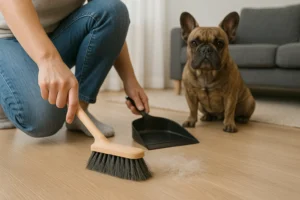Is your Frenchie stressed? then this guide is for you. This handbook is easy to follow and has daily routines that can assist French bulldog owners deal with behaviour difficulties. It talks about the personality of French bulldogs in simple terms and offers easy remedies and regular routines for frequent problems. Without any medical advice or complicated language, readers will find recommendations for teaching their French bulldog, tools to use at home, and links to reliable sources including the AKC, ASPCA, and RSPCA. (American Kennel Club)
Quick Answer
Most frenchie behavior problems improve with consistent routines, rewards for calm choices, and small environment tweaks. This article covers short training sessions, management ideas, and simple record-keeping. It uses positive reinforcement, clicker training, and calm mat training so families can act today. References point to beginner-friendly pages; the focus is behavior skills, not health topics or diagnoses. (American Kennel Club)
Frenchie Temperament
French Bulldogs are smart, playful, and love people. They like brief instruction and regular rewards, but they can get out of hand when their routines slip. Owners who socialise their pets early and desensitise them to loud noises report better behaviour at home and outside. Short cues and timely incentives help the dog comprehend what you want and perform it again. AKC articles back this up.(American Kennel Club)
Core Approach (Foundation Skills)
Start with reward-based french bulldog training tips: mark the exact moment the dog makes a good choice, then pay promptly. Use a clicker or a marker word, keep sessions under five minutes, and reset before your dog fades. To help your dog focus while on walks, add a quiet mat training cue for settling down and a “check-in” with a loose leash. (American Kennel Club)

The 12 Common Problems (with simple fixes)
1) Separation-related fussing
Owners build short alone-time sessions, add peaceful activities, and log small wins each day. The RSPCA’s “left alone” advice shows how to set up time apart and keep it calm. This practical plan favors routine, predictability, and gentle progress for household schedules and workdays. (RSPCA)
2) Excessive barking
To start, lower the triggers at windows, doors, or fences. Mark three seconds of silence, then give a reward. Slowly increase the amount of time you spend in silence. The RSPCA’s barking page lists typical reasons why dogs bark and gives owners tips on how to stop it in busy neighbourhoods or apartments. For continuous improvement, keep sessions brief and fun. (RSPCA)
3) “Stubborn” moments
Reduce difficulty and increase reward value when cues seem optional. Prioritise simple behaviours before introducing distractions. Uncertain training images are often the cause of “stubborn” moments. AKC trainers advise breaking the task up into small, manageable victories that create momentum and rewarding what you want to see again. (American Kennel Club)
4) Chewing the wrong things
Provide permissible chews, switch up your options, and trade gently for prohibited goods. “Find it” games with shoes and cords are eliminated in tidy zones. After play breaks out, reinforce a settle on the mat. Fair outlets and well-defined boundaries channel energy and safeguard cherished household items without harsh adjustments. (ASPCA)
5) Protecting resources, such as food or toys
Teach easy trades, add distance around valued items, and log patterns. Pay generously for calm choices and use neutral spaces for practice. Consistency reduces guarding rehearsals and keeps family routines smooth during mealtimes and guest visits. Use a trainer if patterns persist beyond basic management. (ASPCA)
6) House training errors
Timing, supervision, and quick rewards outside are the keys to success. Select a single door and location, restrict roaming, and use a crate or small pen in between excursions. Owners can use the schedules and reward timing described in the AKC’s potty training guides with puppies or adopted adults.(American Kennel Club)
7) Leash pulling
Switch to a front-clip harness, stand still when the leash tightens, and pay for slack every few steps. Add a “check-in” cue before moving again. As Compared to lengthy, chaotic outings, preffer short loop walks around the block with scheduled pauses help people form habits more quickly. (RSPCA)
8) Leash reactivity
Increase distance from triggers, reward eye contact, and practice smooth U-turns. Short, planned sessions help more as compared to surprise encounters. You should Keep notes on locations and times so that you can go for “easy wins” before raising difficulty. If needed, hire a trainer for a neighborhood plan and realistic milestones. (RSPCA)
9) Jumping on guests
Stage greetings with a leash or hallway gate. Ask for sit, then reward four paws on the floor. Repeat tiny, polite reps before inviting friends to try. Finish sessions with a calm mat settle so the dog learns how visits start and end every time. (American Kennel Club)
10) Zooms and over-arousal indoors
Start with a quick round of tug or a short fetch burst—just enough to take the edge off.
Give your mat cue (like “mat” or “place”).
When your dog lands there, quietly reward—soft praise, a calm treat, maybe a slow ear rub.
Do that little pair three times in a row: play → mat → quiet reward. Then clearly end the session—“all done,” toys away, lights vibe down. With a clear beginning and ending, your dog isn’t left guessing, and it’s much easier for them to exhale, curl up, and nap. (American Kennel Club)
11) Nipping in play
Change hands for toys, stop playing as soon as teeth make contact with the skin, and start again when you feel calm again. Play softer games and take short breaks to keep arousal low. Young dogs can switch gears without losing the fun with a treat scatter or sniffing reset. (ASPCA)
12) Noisy rest periods
Many owners report loud snorts or snores at rest. Focus on quiet zones, smooth airflow in rooms, and a calm wind-down routine. If noise disrupts daily life, book a trainer for schedule tweaks and sleep hygiene ideas, then keep notes on what works best. (RSPCA)

Simple Routines Table
| Problem | 60-second fix | Daily habit | Tool |
|---|---|---|---|
| Barking | Block view, mark quiet | Grow silence to 10 seconds | Treat pouch |
| Leash pulling | Stop on tension | Pay every 3–5 slack steps | Front-clip harness |
| Chewing | Trade for toy | 10-minute chew after meals | Rotating chew bin |
| House training | Guide to spot | Same times each day | Timer on phone |
| Jumping | Ask for sit | Door drill each evening | Mat near door |
Owner Toolkit & Paperwork
Keep training simple with a small go-bag. Stock it with:
- Front-clip harness for easy control
- 6-ft leash for comfortable walks and practice
- Treat pouch so rewards are always on hand
- Puzzle feeder to burn brain energy
- Clicker for crisp timing
- Crate or pen for safe downtime and management
- Washable mat for a clear “go settle here” spot
Bringing home a pup? Ask for a basic puppy contract and a written health guarantee so everyone’s on the same page.
For reliable behavior info, browse the behavior sections from AKC and ASPCA, plus vet-backed guides from VCA and RSPCA. (American Kennel Club)
FAQs
- Do french bulldogs have separation anxiety? — Sometimes, yes.
Some dogs struggle when left alone. Short practice sessions, enrichment, and steady routines usually help. For tailored plans, a qualified trainer can stage distances and durations at a comfortable pace. (RSPCA)
- How to stop a french bulldog from barking?
Reduce triggers, pay for brief silence, and grow the time calmly. Use management at windows and yards, and practice daily in short sessions for best results. (RSPCA)
- Why is my french bulldog so stubborn?
Most of the time, they’re not being difficult—they’re just unsure, tired, or not getting paid well enough for the thing you want. (American Kennel Club)
Try this:
- Pay fast. Mark the moment they do it (a click or “yes”) and treat right away.
- Make it tiny. Break the task into baby steps so your dog can win a lot.
- Upgrade the paycheck. Use better rewards for harder stuff (cheese > kibble).
- Keep it short. 60–90 seconds of practice, then a break.
- Set the scene. Start in a quiet room with non-slippery floors; add distractions later.
Example: If “sit at the door” is failing, try
- sit away from the door → reward,
- sit one step closer → reward,
- sit by the door with the handle jiggle → reward.
Three quick wins beat one big struggle.
- Are french bulldogs aggressive?
Generally, no. Most are friendly companions. If tension shows around toys or space, use trade games, structure, and early help from a trainer. (ASPCA)
- How to potty train a french bulldog?
Keep it simple: same times, fast rewards, little freedom.
Your daily rhythm
- Go out on the big triggers: right after waking, after meals, after play, before bed.
- Add a timer between trips: puppies often need to go every age in months + 1 hours (so a 3-month pup = ~4 hours max, often less).
How to do each trip
- Leash to a single potty spot. Less wandering, faster success.
- Say your cue (“go potty”). Stand still and quiet.
- The second they finish, mark and pay—“yes!” + treat within 2 seconds, then a short sniff/walk as a bonus.
Between trips = managed freedom
- Crate or pen when you can’t watch. It’s not a timeout; it’s a success tool.
- Tether or gate when out with you so you’ll catch those pre-potty signs (circling, sniffing, bee-line to the rug).
If there’s an accident
- Interrupt calmly (“outside”), take them out, and clean with an enzymatic cleaner. No scolding—fear slows learning.
Night & naps
- Out → nap/crate → out again.
- Consider lifting the water bowl 1–2 hours before bed (don’t restrict if it’s hot or after exercise).
Frenchie-specific tips
- Short legs + big feelings: rain, heat, or cold can stall them. Use a covered spot, umbrella, or turf square to keep momentum.
- Keep sessions short; they overheat easily.
- Lots of tiny wins > long outings. Fade treats later; keep the “potty party” early on.
You’ve got this—steady schedule, quick rewards, and limited roaming are the whole game.
- How to stop french bulldog chewing?
Offer rotating chews, supervise, trade calmly for off-limits items, and add short settle drills after play. (ASPCA)
How to stop leash pulling french bulldog?
Stop on tension, pay for slack steps, and keep early walks short with planned check-ins. (RSPCA)
Conclusion
Owners can manage french bulldog behavior issues by rewarding calm choices, staging easy wins, and logging patterns. With positive reinforcement, registration vs eligibility never enters the picture—just clear habits that fit family life. Use the table as a daily anchor, then explore AKC, ASPCA, RSPCA, and VCA resources for extra ideas that stay friendly and practical. (American Kennel Club)
References
- AKC – Training with rewards & positive reinforcement (marker timing, rewards). (American Kennel Club)
- AKC – Potty training guides (puppies and adults). (American Kennel Club)
- ASPCA – Common dog behavior issues (owner-friendly tips). (ASPCA)
- RSPCA – Barking advice and training basics (lead manners, being left alone). (RSPCA)
- AKC – French Bulldog breed info (temperament overview). (American Kennel Club)



